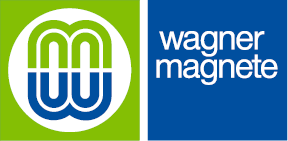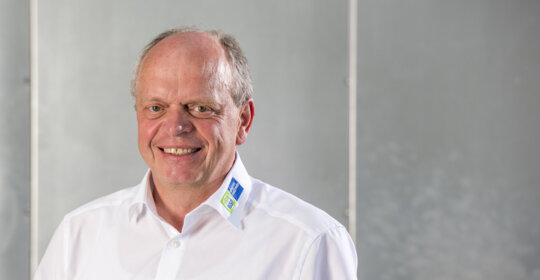Comprehensive guide
For WORK With magnets
Magnetic separator
What characterises the stainless steel Scheider?
Many stainless steels that can only be weakly magnetised and therefore could not previously be deposited are held by the roll. Due to the large spatial expansion of the magnetic field, even unfavourably shaped stainless steel parts are optimally magnetised.
The stainless steel parts are caught by the magnetic roller and pulled out of the material flow on its underside.
Are electromagnets less strong with increasing heat?
How does a non-ferrous separator using eddy current technology work?
Aluminium, magnesium, copper, aluminium alloys and silver can be deposited particularly well with this type of separation. The size ratio is less favourable for zinc, brass and tin. Many high-alloy steels cannot be separated.
Why do metal detectors need a "metal-free zone"?
Metal detectors use a transmitter to generate a weak alternating magnetic field. This magnetic field is continuously monitored by the receiver. As soon as a metal part enters the magnetic field, its strength and shape change locally. These slightest field changes are recognised by the evaluation electronics as a passing metal part.
All metal construction parts in the environment also affect the magnetic field of the metal detector in their entirety and thus generate a constant background noise of interference signals. By taking the "metal-free zone" into account, it is ensured that the interfering structural parts are at a sufficient distance from the probe's search field. As a general rule, doubling the distance from the search field reduces the interference from metal parts by a factor of four.
Why do we recommend installing shielding plates in front of the nearest roller stations for metal detectors?
If a piece of wire is bent into a ring (conductor loop) and placed in the electromagnetic field of a metal detector, eddy currents (flowing in a circle) are induced in this ring. As a result, the surface enclosed in the ring acts on the field like a metal surface of the same size. If the ring is opened at any point, only the very small surface of the thin wire acts on the field of the metal detector. For the metal detector, unstable conductor loops act like very large metal surfaces that move quickly through the magnetic field.
roller stations always form conductor loops with the surrounding belt construction. These conductor loops can become unstable if the rollers bounce in their mounts, if the contact surfaces corrode or if the ball bearing grease is pushed between the balls and bearing shells during movement. The first rollers in front of and behind the probe (also in the lower belt) are the main cause of such faults. By attaching solid steel plates in front of the nearest roller stations, these (and all subsequent) roller stations can no longer interfere with the metal detector.
Why is it better to operate overbelt solenoids in longitudinal discharge?
The space available within a system often restricts the installation options for overbelt magnets. The magnets are usually suspended transversely above the conveyor belt. However, longitudinal suspension on the belt discharge has advantages over this: The separation rate is increased as the material is in free fall and the ferrous parts are released from the bulk material. The attracted ferrous parts cannot jam on the edge of the conveyor belt during discharge. In the longitudinal arrangement, the head roller of the conveyor belt must be made of non-magnetic material.
Why is it not possible to precisely predict the deposition rates of magnetic separators?
Separation rates can be determined and reproduced under laboratory conditions. In real operation, however, it is unrealistic to define exact percentage separation rates because they depend on too many uncontrollable boundary conditions: Particle size distribution, size ratio of metal to good material, size, weight and shape of metal parts, amount of metal content in composite materials, position of metal parts in the conveying stream. High separation rates are achieved if the starting material is optimally prepared (narrow screen cut, dedusting) and fed (uniform, low layer height) or if a slightly higher level of contamination of the metal fraction is tolerated. In principle, the following applies: The extraction rate counteracts the metal purity, both parameters cannot be optimised simultaneously with only one separation stage. Information on realistic separation rates can be found in the DIN VDI 3623 standard.
Why must a non-magnetic zone be provided for magnetic separators?
The effective range of the magnetic field of lifting magnetic separators is mainly located below the magnetic block. However, lateral scattering cannot be avoided. The magnetic field causes magnetisation of all steel parts in the effective area and in the scattering area. This influences the shape, direction and intensity of the magnetic field.
Iron parts in the effective range of the magnet become magnetic themselves and neutralise the lifting effect of the magnetic separator in their surroundings. Iron parts in the scattering range of the magnetic separator deflect the field lines out of the effective range and weaken the lifting effect of the entire magnetic field.
Ferrous parts in the ejection area of the magnetic separator become magnetic themselves and can influence the clean ejection of the ferrous parts in such a way that the initially lifted ferrous parts fall back into the material flow.
How is the optimum working distance for overband magnetic separators determined?
The working distance must be selected so that the excavated iron parts are discharged without collision. In addition, the discharge belt of the magnetic separator must not touch the conveyor system. For fine-grained material and small iron parts, a distance of 50 - 100 mm from the material layer is often sufficient; for coarse-grained bulk material, discontinuous conveying and large iron parts, much greater distances are often selected.
Which stainless steels can be magnetically deposited?
Stainless steels are roughly categorised into ferritic, martensitic and austenitic structures depending on their alloy components. Ferritic microstructures are predominantly magnetic, austenitic microstructures are predominantly non-magnetic and martensitic microstructures are partially magnetic. The composition of the microstructure determines whether the magnetic properties of the iron content can develop or not.
Stainless steels can also consist of several microstructures with different compositions and properties. The majority of common stainless steel grades tend to be non-magnetic. However, the stainless steel structure can change its magnetic properties when subjected to high pressure. For example, an originally non-magnetic, austenitic stainless steel part can develop a magnetic, martensitic structure at the deformation points. This effect can increase the output rate of stainless steel separators. To achieve this, it is necessary for the microstructure to be mechanically altered immediately before separation, for example by crushing in a cross-flow flaker.
Clamping technology
How can the magnetic holding force of a clamping solenoid be measured?
With clamping magnets, the holding force is measured using a standard holding force load cell. A defined steel body is torn off hydraulically via a pressure piston. The pull-off force is measured in N/cm².
Furthermore, the displacement force of a defined sample part can be displaced by means of a displacement force device and thus measured. WAGNER MAGNETE also carries out tests with customer workpieces to select the optimum magnetic clamping technology.
Can the holding force of a clamping solenoid be adjusted?
All electromagnets and electro-permanent magnets are controlled via a WAGNER pole reversal control unit. The holding force can be set between 6, 8 or 16 levels via corresponding control signals. The control signals can come from a higher-level machine controller or a manual coding switch.
The gradation of the holding force levels is linear. An additional software package (monitor programme) can be used to change the position of the individual stages in the 0.1 % range. The holding force cannot be adjusted for permanent magnets.
How does the surface quality of a workpiece affect the holding force of a clamping magnet?
The surface quality of a workpiece plays a key role in the holding force. The evenness of the contact surface also has a major influence on the holding force of the workpiece. The best values are achieved with a finely ground surface without an air gap.
Painted, scaled surfaces or a deformed contact surface of the magnet are disadvantageous.
With larger pole pitches, the holding force is higher with small air gaps.
What happens in the event of a power failure?
An electromagnet loses its holding force after the supply voltage is switched off.
Why are there different pole pitches/pole distances?
The centre-to-centre distance between two neighbouring unequal magnetic poles is called the pole distance. The magnetic field depth at the magnet surface is approximately half the pole distance.
A small pole distance is therefore used for small or thin workpieces. A large pole distance is used for large and thick workpieces.
What is the adhesive force with different materials?
Alloy components such as chromium and nickel impair the magnetisability of steel and therefore also the holding force. The structure of the materials is also changed by tempering and hardening, thus impairing the magnetic flux.
How is the current transmitted with round magnets?
Another option is a so-called plug contact on the magnet. When the spindle is stationary, the supply cable is plugged in and the magnet is magnetised. The plug with the supply cable is then removed again and the plug contact is sealed watertight (however, this is only possible with electro-permanent magnets).
Demagnetising
What does magnetisation mean?
These components are very often magnetised by transport magnets or by holding them on magnetic clamping systems.
What does demagnetisation mean?
Demagnetisation of a magnetised ferromagnetic body can be achieved if the aligned elementary magnets are mixed again.
This can be achieved by heating, strong vibration or a strong alternating magnetic field.
Why should materials be demagnetised?
The need to demagnetise materials arises for a variety of practical and technical reasons. For example, magnetic components can attract other metal parts and thus disrupt other manufacturing processes. This is particularly necessary for subsequent cleaning with industrial washing systems or for subsequent ultrasonic testing.
To summarise, demagnetisation is necessary in electrical engineering, medical technology and quality assurance in order to ensure the safety, efficiency and quality of end products. It is an essential step to ensure that devices and machines function optimally and that undesirable side effects of magnetic forces are avoided.
How is demagnetisation carried out in practice?
Selection of the demagnetiser?
- 211-15/... -> approx. 30 mm
- 211-17/... -> approx. 50 mm
- 211-40/... -> approx. 90 mm
The effective depth is further increased by an upstream low-frequency generator.
When is a low-frequency generator needed?
It can be used to demagnetise at either 50 Hz or 16 2/3 Hz. It is particularly suitable for critical applications - such as high-alloy or hardened materials, large-volume workpieces, bulk parts or bulk material. Maximum field strengths and a particularly high depth effect are achieved with the low-frequency generator. Other special features include field strength adjustment via BCD-coded inputs, monitoring of the demagnetising function and adjustable switch-off process (ramp).
Hold & transport
What is the area of application for lifting magnets?
Lifting magnets are used for transport and handling technology. We offer everything from the smallest robot gripper magnets to heavy-duty magnets for harbour facilities and steelworks. There are electro-permanent magnets and electro-magnet systems for a wide variety of tasks.
Complete units with traverses, magnet systems, support batteries and control systems are used for handling heavy plates. Other applications range from the transport of ferromagnetic workpieces for loading and unloading on machine tools to the automated handling of small parts in the automotive industry.
What is the structure of an electric lifting magnet?
The magnetic field is generated by the DC excitation winding in the magnet system. The coil encloses an iron core which is connected to the outer housing. This creates north and south poles. Depending on the design, very high holding forces can be achieved with deep-acting magnetic fields.
Electromagnets only hold parts in place as long as direct current flows to the magnet. After switching off or in the event of a power failure, the parts are released.
If the lifting magnet is not used exclusively in secured areas, EN13155 requires a backup battery and an automatic warning device to signal a power failure.
How does an electro-permanent lifting magnet work?
In electro-permanent magnets, the iron core is replaced by permanent magnet material. This can be magnetised by means of a short current pulse from the surrounding excitation winding. This generates a permanent magnetic (permanent) holding force that holds the component in place even without a further current supply. This makes these systems an absolutely safe load handling device in handling technology with minimal energy consumption. The full holding force is maintained even in the event of a power failure or cable break.
The magnet is switched off by an opposing demagnetising pulse. A pole-reversal control unit is required to operate the electro-permanent lifting magnet.
When do I use an electric lifting magnet or an electric permanent lifting magnet?
Large electric lifting magnets are mostly used in harbour facilities, steelworks, shipyards or for handling large steel plates. These magnets bridge an air gap caused by unevenness very well. If the electric lifting magnet is not used exclusively in a secured area, a backup battery and an automatic warning device to signal a power failure are required in accordance with EN13155.
Smaller electric lifting magnets can be used for transporting and handling steel products and for holding ferromagnetic parts economically in production and fixture construction. They are also very often used for handling small parts and bulk goods in conjunction with a robot or automated handling system.
Electro-permanent lifting magnets are also used to transport large steel plates and workpieces. A major advantage is the rapid magnetisation via a current pulse with a pole-reversal control unit. The workpiece is then held without any further power supply. This pulse control ensures low energy consumption with minimal self-heating.
A high-maintenance battery system, as with the use of electromagnets, is therefore not necessary. In the event of a power failure, the magnet retains its adhesive force - the workpieces do not fall off!
Smaller permanent electric lifting magnets are very often used for loading and unloading workpieces on machine tools. Electro-permanent lifting magnets are widely used in automated applications with robots, including in the automotive industry.
Can you also transport round workpieces (pipes, shafts)
The electro-permanent lifting magnets of the 5190N series are used to transport shafts and pipes.
The integrated bipolar double magnet system achieves very high load-bearing forces with a low magnet weight. The round workpieces are held securely with easy-to-fit prism-shaped pole shoes. The narrow design with optimised pole shoes enables individual workpieces to be picked up when shafts are lined up.
Depending on the design, different diameters can be picked up with prism-shaped pole shoes. If the pole shoes are adapted to the workpiece contour (surface contact), the load capacity can be increased even further.
How can I ensure the holding force of a transport magnet?
Ensuring the holding force of a transport magnet is crucial to ensure safe and efficient handling and transport of materials. Firstly, it is important to select the right magnet for the application in question. This means that the magnet should be suitable in terms of size, shape and magnet type for the material to be transported. It is also crucial to know the maximum load that the magnet should carry and to ensure that this value is not exceeded.
In order to achieve the full magnetic force, the entire pole surface of the magnet must be in direct contact with the load during magnetisation. Only partially covering the pole surface reduces the holding force.
The condition of the magnet and the material to be held also influence the holding force. A clean, rust-free and even surface on both sides improves the contact and therefore the holding force.
Another decisive factor is the thickness of the material to be held. If the material is too thin, the holding force of the magnet decreases.
You should also check the magnet regularly for signs of wear or damage. A deformed pole surface or wear and tear can affect the holding force and jeopardise safety.
Are there safety regulations for handling lifting and transport magnets?
When handling lifting and transport magnets, safety and caution are of the highest priority, as the safety of the operator and the protection of the transported goods are both at stake. There are therefore various safety regulations and recommendations that should be observed.
First and foremost, lifting and transport magnets should always be used in accordance with the load limits specified by the manufacturer. Exceeding these limits can not only damage the magnet, but also increase the risk of sudden load loss, which can lead to serious injury or damage.
Harmonised standards applied are DIN EN ISO 12100:2011 and DIN EN 13155:2009.
Control technology
What is control technology?
What advantages does Wagner magnet control technology offer over the competition?
Compared to its competitors, control technology offers a number of decisive advantages that make it indispensable in modern industry and technology. With modern control systems, the activity and intensity of magnetic fields can be regulated with high precision, leading to optimised work processes and better results. Compared to competitor products, we can score with very high reliability and extreme flexibility.
To summarise, the control technology offers advantages over competitor products in terms of precision, reliability and flexibility, making it a decisive tool in magnetic technology.
Can the control technology from Wagner Magnete be used for all solenoid types?
Control technology in magnet technology is a multi-faceted field and has been developed to interact with a variety of magnet types. Basically, control technology can be designed for any type of magnet as long as the specific requirements of the magnet are taken into account. For example, permanent magnets can be controlled by electromagnetic means to temporarily influence their magnetic properties. Electromagnets, on the other hand, are inherently suitable for control as their magnetic force is regulated by switching the electric current on and off.
To summarise, the control technique can potentially be used for all types of magnets, with the actual implementation depending on the type of magnet, its application and other technical considerations.
How easy is it to integrate Wagner magnet control technology into existing systems?
The integration of Wagner magnet control technology into existing systems is designed so that it can be controlled with any industrial control system (PLC). WAGNER MAGNETE, , with its many years of experience and expertise in the field of magnet technology, has developed its control systems with flexibility and compatibility in mind.
The company provides the resources and expertise of its staff to help technicians and engineers maximise the benefits of control technology. The expertise of our development engineers is available to customers for difficult commissioning tasks.
How safe are the control systems from Wagner Magnete?
Safety is a key concern in the development and implementation of control systems, especially in industries that work with critical applications and high-performance technologies. At WAGNER MAGNETE, we take this aspect very seriously, which is why we have invested considerable resources and research into the safety of our control systems in recent years.
WAGNER MAGNETE control systems are designed to provide reliable and trouble-free performance. They utilise advanced technologies and algorithms to ensure that magnet applications are controlled accurately, efficiently and safely. With built-in redundancies and fault protection mechanisms, our systems are designed to detect potential faults and act proactively before they can lead to serious problems.
Equally important is the continuous development and improvement of our control units.
The company
What is the main mission of your company?
WAGNER MAGNETE's main mission is to utilise their over 85 years of experience and innovation potential to provide standard and customised solutions in the field of magnet technology together with their customers worldwide. Their focus is on clamping and holding magnets as well as the magnetic separator sector, ensuring quality, durability and first-class support.
In their own technical centre, they work continuously on the development, testing and optimisation of their products as well as on individual solutions. This enables them to constantly expand their technical expertise and offer their customers perfect quality.
WAGNER MAGNETE endeavours to provide their customers with comprehensive and honest advice to ensure the feasibility of their requirements. Whether standard products or customised solutions are required, the company puts its customers' wishes into practice .
Their wide range of magnets and magnet solutions are used in various industries such as mechanical engineering, automotive, medical technology, aerospace and renewable energy. Thanks to long-standing partnerships, they understand the specific requirements of these industries and offer both standard products and customised solutions in certified quality.
How long has your company been around?
WAGNER MAGNETE GmbH & Co KG from Heimertingen has been in existence for over 85 years. Founded by Georg Wagner, it has developed over three generations into a globally recognised specialist for magnet technology. Under the management of Mr Wolfgang Wagner in the third generation, the company has continuously used innovation, inventiveness and creativity to develop itself further.
Working with magnets has changed significantly since the company was founded in 1935, particularly in terms of material availability, manufacturing methods and application technologies. WAGNER MAGNETE has played an important role during this time by developing innovative solutions for various applications.
Over the years, the company has also specialised in permanent magnets and high-precision electro-permanent clamping magnets. WAGNER MAGNETE 's continuous innovation work has helped to expand the application possibilities of magnets in various industries and improve their performance and reliability.
In which countries or regions do you operate?
- Australia
- Belgium
- China
- Germany, India
- India
- Iran
- Ireland
- Israel
- Italy
- The Netherlands
- Austria
- Oman
- Poland
- Romania
- Russia
- Sweden
- Spain
- South Africa
- Turkey
How do you guarantee the quality of your products/services?
The quality of our products and services at WAGNER MAGNETE is the result of a careful combination of expertise, research and development and dedicated employees. With a wide range of applications and technologies in magnet technology - from clamping magnets to demagnetising devices and magnetic separators - we have many years of experience in international markets.
Our in-house specialists in development, design, electronics, sales and field service are passionate about realising new ideas. We use modern technical tools, such as simulation and calculation programmes, to ensure that the design of our products corresponds to the latest findings in magnetic technology. All our components fulfil the requirements for electromagnetic compatibility (EMC ) and bear the CE mark, which confirms compliance with the relevant EU regulations.
The high quality of our products, which are manufactured in Germany, is reflected in our position as world market leader in control technology. Our production at the main site in Heimertingen enables us to maintain close control over the production process. We also have our own technical centre where we drive research and development in order to develop innovative solutions and continuously improve products.
Our employees are at the heart of our success. With 160 dedicated employees, we pride ourselves on a good working atmosphere and a strong team spirit. This shared experience and expertise contribute to our quality and our success.
Overall, at WAGNER MAGNETE we ensure the quality of our products and services through comprehensive expertise, continuous research and development, modern production methods and dedicated employees who put the needs of our customers at the centre.
How is your company committed to sustainability and environmental protection?
At WAGNER MAGNETE, we take our responsibility for sustainability and environmental protection very seriously. Our commitment is reflected in concrete measures aimed at minimising our ecological footprint and making a positive contribution to the environment .
One outstanding example is our investment in an impressive solar plant with a capacity of around 500 kW. This plant is a clear commitment to renewable energy sources and their importance for a sustainable future. By utilising solar energy, we cover a significant part of our energy requirements from environmentally friendly sources. This allows us to significantly reduce our CO2 emissions and actively contribute to the mitigation of climate change.
Our solar installation is not only a technological highlight, but also a symbol of our commitment to environmental protection. We are proud that this initiative not only reduces our own energy costs, but also has a positive impact on the environment . This project not only serves as a role model for sustainable energy practices, but also inspires other companies to recognise their responsibility to the environment and take similar steps.
The implementation of this solar installation is just one part of our holistic approach to sustainability. We are continuously committed to environmentally friendly production methods, resource efficiency and waste minimisation. Our efforts extend across all areas of our business, from product development to manufacturing and day-to-day operations.
Overall, our solar initiative at WAGNER MAGNETE demonstrates that we are not only developing innovative magnet technology , but also doing our bit to tackle pressing environmental issues. We believe that through such actions, companies can make a positive change and we look forward to continuing to fulfil our responsibility to the environment and continuously expanding our efforts.
What career opportunities are there in your company?
We offer a wide range of career opportunities in our company. Our employees are at the heart of our success and we place great importance on enabling them to develop their talents.
Our working environment encourages initiative and commitment, while our extensive training programme ensures that our employees are always up to date and can continuously develop their skills. Our personalised support and training help to ensure that personal and professional goals can be achieved.
With us, you have the opportunity to work in various areas, including commercial professions, electrical professions, mechanical production and assembly as well as development and design. We emphasise teamwork, innovation and personal growth.
Our corporate culture is based on openness and appreciation, and we strive to create a working environment in which our employees feel comfortable and valued in the long term. We offer not only competitive remuneration, but also a variety of benefits that contribute to the motivation and satisfaction of our employees.
We are looking for committed and talented people who are ready to advance their career with us and make a lasting contribution to our success. If you want to work in a dynamic environment and develop your skills, we look forward to accompanying and supporting you on your career path.





